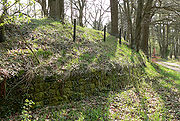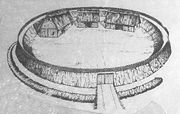
Circular rampart of Burg
Encyclopedia

Early Middle Ages
The Early Middle Ages was the period of European history lasting from the 5th century to approximately 1000. The Early Middle Ages followed the decline of the Western Roman Empire and preceded the High Middle Ages...
period located near the German town of Celle
Celle
Celle is a town and capital of the district of Celle, in Lower Saxony, Germany. The town is situated on the banks of the River Aller, a tributary of the Weser and has a population of about 71,000...
in Lower Saxony
Lower Saxony
Lower Saxony is a German state situated in north-western Germany and is second in area and fourth in population among the sixteen states of Germany...
. The site, dating roughly to the 10th century and located in an inaccessible area of marsh by the River Fuhse, probably acted as a refuge for the local population. Today this 3 metre high circular embankment belongs to one of the most important Early Middle Age historical monuments in Celle.
Location


Altencelle
Altencelle is part of the borough of Celle in Lower Saxony and lies southeast of the town centre, west of the River Aller and east of the Fuhse. It is linked to Celle by the B 214 federal road and state highway K 74.- History :...
, several hundred metres west of the settlement of Burg. It is easily accessed via an improved road and a field track. Formerly this defensive work lay on a sand dune in the middle of the wide, flat valley of the Fuhse. At that time the river ran northwards past the Burg, because another rampart was built to the south of the circular rampart with ditches in front of it. Today the river flows southwards past the site.
Description
In spite of the surrounding land being cultivated in past centuries the almost perfectly circular rampart, 70 to 85 metres in diameter whose interior covers about 0.2 hectare (0.494210326030552 acre), is well preserved. It still retains its original height of 3 metres. The rampart was made of plaggen, turves cut from peat bogs. In front of it to the south, facing the direction of attack, is a dry V-shaped ditch (Spitzgraben), 2 m deep and 6 m wide. Between the rampart and the ditch is a 5 m wide bermBerm
A berm is a level space, shelf, or raised barrier separating two areas. Berm originates in the Middle Dutch and German berme and came into usage in English via French.- History :...
. The ditch was crossed by an earth bridge that led to the only entrance on the eastern side of the rampart. This is still visible today as a break in the embankment. To the north protection was afforded by the River Fuhse which, at that time, was about 50 m from the position.
A flight of stone steps has been built for visitors today leading to the top of the rampart. Stones have also been laid at the foot of the rampart in recent times. In front of the rampart is an information tablet with an explanation of the historical significance of the site.
Excavations
The first archaeological investigation was undertaken in 1906 by the archaeologist, Carl SchuchhardtCarl Schuchhardt
Carl Schuchhardt was a German archaeologist and museum director.Schuchhardt studied classical philology, modern languages, and archaeology in Leipzig, Göttingen and Heidelberg...
, who cut through the embankment profile. This confirmed that the embankment had been built purely from plaggen, no remains of old wooden reinforcements being found.
A second dig took place between 1935 and 1936 carried out by the historian, Ernst Sprockhoff. He cleared a good third of the interior of the rampart.
This revealed post sockets which suggest that there were three buildings inside the site immediately next to the embankment. They would appear to be a 20 x 7 m hall, a secondary building and a barn. The entrance in the rampart was discovered, comprising an entrance passageway with wooden posts on either side and measuring 3 x 5 m. Finds included individual shards of pottery, a rusted knife and several horseshoes. These dated the defensive position to the 10th century. The find indicated only a short period of settlement. Sites of similar construction were not uncommon on the plains and appeared from the 8th to the 12th century as refuges for the population. During the excavation stone age flint
Flint
Flint is a hard, sedimentary cryptocrystalline form of the mineral quartz, categorized as a variety of chert. It occurs chiefly as nodules and masses in sedimentary rocks, such as chalks and limestones. Inside the nodule, flint is usually dark grey, black, green, white, or brown in colour, and...
s and fireplaces were also discovered. They indicated that the sand dune in the valley of the Fuhse had already been settled in the Stone Age
Stone Age
The Stone Age is a broad prehistoric period, lasting about 2.5 million years , during which humans and their predecessor species in the genus Homo, as well as the earlier partly contemporary genera Australopithecus and Paranthropus, widely used exclusively stone as their hard material in the...
.
Adaptation
This well-preserved circular rampart gained renewed fame in the early 20th century, thanks to the novel Der Wehrwolf (The Werewolf) by Hermann LönsHermann Löns
Hermann Löns was a German journalist and writer. He is most famous as "The Poet of the Heath" for his novels and poems celebrating the people and landscape of the North German moors, particularly the Lüneburg Heath in Lower Saxony. Löns is well known in Germany for his famous folksongs...
. Löns was inspired by the rampart site and set parts of his work at this location during the Thirty Years War. According to the novel marauder
Marauder
A marauder is a bandit, outlaw, raider or such like who moves about in roving fashion looking for plunder.Other uses of marauder, usually derived from the above include:in " Football"...
s and other warring groups passed through the land and plundered the farms of the heath farmers. The farming folk retreated to the old refuge. According to Löns Roman they fortified the site and built houses within its interior. One day they defended themselves successfully against an attack by Swedish Landsknecht
Landsknecht
Landsknechte were European, predominantly German mercenary pikemen and supporting foot soldiers from the late 15th to the late 16th century, and achieved the reputation for being the universal mercenary of Early modern Europe.-Etymology:The term is from German, Land "land, country" + Knecht...
s ( pikemen with supporting infantry).

